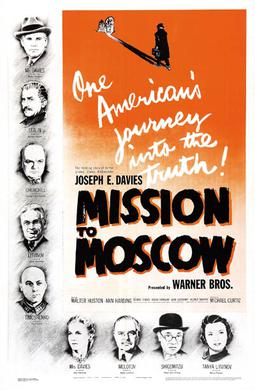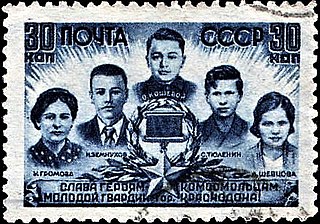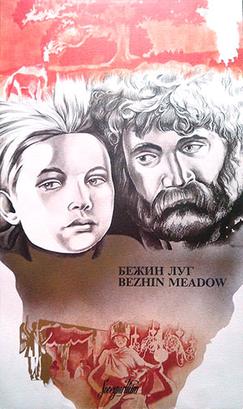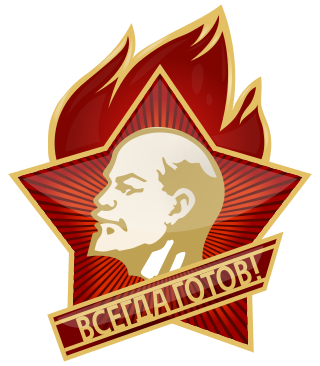A cult of personality, or a cult of the leader, is the result of an effort which is made to create an idealized and heroic image of a glorious leader, often through unquestioning flattery and praise. Historically, it has developed through techniques of mass media, propaganda, spectacle, the arts, patriotism, and government-organized demonstrations and rallies. A cult of personality is similar to apotheosis, except that it is established by modern social engineering techniques, usually by the state or the party in one-party states and dominant-party states. Cults of personality often accompany the leaders of totalitarian or authoritarian governments. They can also be seen in some monarchies, theocracies, failed democracies and even in liberal democracies.

Vasily Grigoryevich Zaitsev was a Soviet sniper during World War II.
The Anti-Zionist Committee of the Soviet Public was a body formed in 1983 in the Soviet Union as an anti-Zionist propaganda tool. Formation of AZCSP was approved on 29 March 1983 by the Secretariat of the Central Committee of the Communist Party of the Soviet Union in resolution 101/62ГС: "Support the proposition of the Department of Propaganda of the Central Committee and the KGB USSR about the creation of the Anti-Zionist Committee of the Soviet Public..."
Soviet anti-Zionism is an anti-Zionist and pro-Arab doctrine promulgated in the Soviet Union during the Cold War. While the Soviet Union initially pursued a pro-Zionist policy after World War II due to its perception that the Jewish state would be socialist and pro-Soviet, its outlook on the Arab–Israeli conflict changed as Israel began to develop a close relationship with the United States and aligned itself with the Western Bloc. Anti-Israel Soviet propaganda intensified after Israel's sweeping victory in the 1967 Arab–Israeli War, and it was officially sponsored by the agitation and propaganda media of the Communist Party of the Soviet Union as well as by the KGB. Among other charges, it alleged that Zionism was a form of racism. The Soviets framed their anti-Zionist propaganda in the guise of a study of modern Zionism, dubbed Zionology. The Soviet anti-Israel policy included the regulated denial of permission for Jews in the Soviet Union to emigrate, primarily to Israel, but also to any other country.

Zoya Anatolyevna Kosmodemyanskaya was a Soviet partisan. She was executed after acts of sabotage against the invading armies of Nazi Germany; after stories emerged of her defiance towards her captors, she was posthumously declared a Hero of the Soviet Union. She became one of the most revered heroines of the Soviet Union.

Mission to Moscow is a 1943 propaganda film directed by Michael Curtiz, based on the 1941 book by the former U.S. ambassador to the Soviet Union, Joseph E. Davies.

The Young Guard was an underground anti-fascist Komsomol organization, in the German-occupied Soviet city of Krasnodon. They were active during World War II, until January 1943. They carried out several acts of sabotage and protest before being destroyed by German forces. Most members of the Young Guard, about 80 people, were tortured and then executed by the Germans.

Censorship in the Soviet Union was pervasive and strictly enforced.

Communist propaganda is the artistic and social promotion of the ideology of communism, communist worldview, communist society, and interests of the communist movement. While it tends to carry a negative connotation in the Western world, the term propaganda broadly refers to any publication or campaign aimed at promoting a cause and is/was used for official purposes by most communist-oriented governments. The term may also refer to political parties' opponents' campaign. Rooted in Marxist thought, the propaganda of communism is viewed by its proponents as the vehicle for spreading their idea of enlightenment of working class people and pulling them away from the propaganda of who they view to be their oppressors, that they claim reinforces exploitation, such as religion or consumerism. Communist propaganda therefore stands in opposition to bourgeois or capitalist propaganda.

Propaganda in the Soviet Union was the practice of state-directed communication aimed at promoting class conflict, proletarian internationalism, the goals of the Communist Party of the Soviet Union, and the party itself.
The Workers International Relief (WIR) — also known as Internationale Arbeiter-Hilfe (IAH) in German and as Международная рабочая помощь in Russian — was an adjunct of the Communist International initially formed to channel relief from international working class organizations and communist parties to famine-stricken Soviet Russia. The organization, based in Berlin, later produced films and coordinated propaganda efforts on behalf of the USSR.

Bezhin Meadow is a 1937 Soviet propaganda film, famous for having been suppressed and believed destroyed before its completion. Directed by Sergei Eisenstein, it tells the story of a young farm boy whose father attempts to betray the government for political reasons by sabotaging the year's harvest and the son's efforts to stop his own father to protect the Soviet state, culminating in the boy's murder and a social uprising. The film draws its title from a story by Ivan Turgenev, but is based on the life story of Pavlik Morozov, a young Russian boy who became a political martyr following his death in 1932, after he supposedly denounced his father to Soviet government authorities and subsequently died at the hands of his family. Pavlik Morozov was immortalized in school programs, poetry, music, and film.
Censorship of images was widespread in the Soviet Union. Visual censorship was exploited in a political context, particularly during the political purges of Joseph Stalin, where the Soviet government attempted to erase some of the purged figures from Soviet history, and took measures which included altering images and destroying film. The USSR curtailed access to pornography, which was specifically prohibited by Soviet law.
During the Cold War (1947–1991), when the Soviet Union and the United States were engaged in an arms race, the Soviet Union promoted its foreign policy through the World Peace Council and other front organizations. Some writers have claimed that it also influenced non-aligned peace groups in the West.
Space propaganda is a form of propaganda relating to achievements in space exploration and space science. It is used primarily to further a nation's perceived technological superiority, through the operation of a state-funded space agency. Space propaganda was first emergent during the Space Race of the mid-20th-century, an indirect extension of the Cold War.

Joseph Stalin's cult of personality became a prominent feature of Soviet popular culture. Historian Archie Brown sets the celebration of Stalin's 50th birthday on 21 December 1929 as the starting point for his cult of personality. For the rest of Stalin's rule, the Soviet propaganda presented Stalin as an all-powerful, all-knowing leader, with Stalin's name and image appearing everywhere.

Pavel Trofimovich Morozov, better known by the diminutive Pavlik, was a Soviet youth praised by the Soviet press as a martyr. Evidence has emerged since the dissolution of the Soviet Union of the fabrication of the Pavlik Morozov legend, as well as what Soviet officials thought of him. His story, dated to 1932, is that of a 13-year-old boy who denounced his father to the authorities and was in turn killed by his family. His story was a subject of reading, songs, plays, a symphonic poem, a full-length opera, and six biographies. His politicized and mythologized story was used to encourage Soviet Bloc children to also inform on their parents.

The Vladimir Lenin All-Union Pioneer Organization, abbreviated as the Young Pioneers, was a compulsory youth organization of the Soviet Union for children and adolescents ages 9–14 that existed between 1922 and 1991.

Political warfare is the use of hostile political means to compel an opponent to do one's will. The term political describes the calculated interaction between a government and a target audience, including another state's government, military, and/or general population. Governments use a variety of techniques to coerce certain actions, thereby gaining relative advantage over an opponent. The techniques include propaganda and psychological operations ("PsyOps"), which service national and military objectives respectively. Propaganda has many aspects and a hostile and coercive political purpose. Psychological operations are for strategic and tactical military objectives and may be intended for hostile military and civilian populations.

Dezinformatsia: Active Measures in Soviet Strategy is a non-fiction book about disinformation and information warfare used by the KGB during the Soviet Union period, as part of their active measures tactics. The book was co-authored by Richard H. Shultz, professor of international politics at Tufts University, and Roy Godson, professor emeritus of government at Georgetown University.














